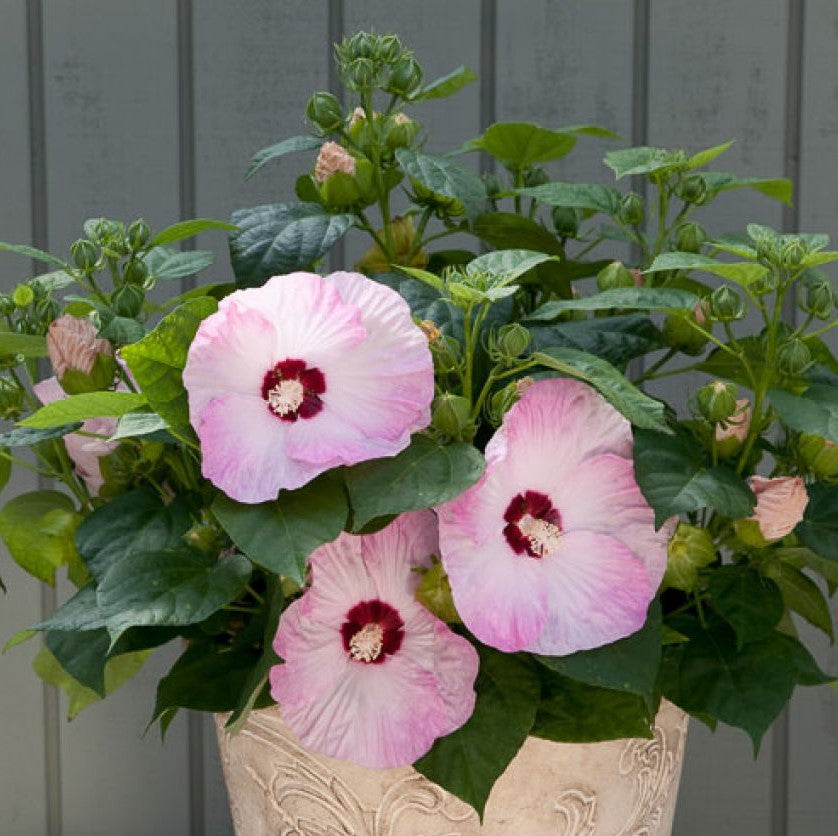by Ken Lain, the mountain gardener

Rosy honeymoon flowers grow 9 inches wide! The bride stopping flowers exude youthfulness and beauty for an instant garden makeover. Arizona’s toughest perennial hibiscus, even in subzero winters. She beautifies sunny gardens, raised beds, and containers for exotic colors summer through fall. Perennial up to 4′ tall.
If you crave a taste of the tropics, try growing hardy hibiscus plants. They often produce flowers larger than any other in the garden, that survive harsh cold winters. She serves as an excellent foundation planting, hibiscus is a colorful addition to any garden. The showy flowers are often referred to as “dinner plate hibiscus,” feature ruffled petals in blues, pinks, reds, and whites.
Botanical Name: Hibiscus moscheutos
Common Names: Hibiscus, rose mallows, swamp mallows
Plant Type: Herbaceous perennials
Mature Size: 3-6′ feet tall and 3′ feet wide
Sun Exposure: 6+ hours of sun
Soil Type: Rich or Loamy
Soil pH: Neutral to slightly acidic
Bloom Time: Summer
Flower Color: White, red, pink, blue
Hardiness Zones: USDA 4-9
Native Area: Eastern North America
How to Grow Hardy Hibiscus Plants
Plant taxonomy classifies the hardy hibiscus plants as Hibiscus moscheutos. They also go by such familiar names as rose mallows and swamp mallows. This hibiscus is a cold-hardy plant despite bearing large blooms that call to mind the tropics. The hues of the most common cultivars are white, bicolored, or various shades of red or pink, but other colors are also available.
Mascheuto Hibiscus seems woody in summer. Their stems do die back to the ground in winter, making them technically herbaceous perennials.
This hibiscus is best used at the back of the perennial bed, as a sub-shrub, or in containers or raised bed.
Some of the most popular hardy hibiscus cultivars reach about four feet in height, with a spread slightly less than that, but the bloom size can be 10″ inches round.
Even cultivars with smaller blooms still produce impressive saucer-sized flowers. While each bloom lives only a day or two, they are quickly replaced in an ever-blooming display last summer through fall.
Light
For your hardy hibiscus plant to bloom to its most enormous potential, it needs about six hours a day of full sun.
Soil
This is a wetland plant, and hardy hibiscus flowers can be treated as plants for wet soils, heavy clay, and silt. So if your landscaping situation is a damp area where most plants die, this hibiscus is your answer. This makes them useful around water features.
Water
If you are not planting hardy hibiscus plants in a wet spot, make sure they are adequately watered. A small plant with fewer leaves needs less water than a large leafy plant in full bloom. Through summer, give your hibiscus a deep soak twice per week. This can be cut back to once per week if a monsoon rain occurs. You should water this plant twice per month in winter or when the soil is dry to the touch.
Fertilizer
Growing hibiscus plants need plenty of nutrients. Feed with 7-4-4 All Purpose Food three times per year for amazing flowers. This natural food is spread like salt-and-pepper around the plant’s base every Easter, July 4th, and Halloween for incredible results.
Propagating
The best way to propagate hibiscus is through stem cuttings. In spring or early summer, cut a new growth or softwood section about four to six inches long. Remove any flowers or flower buds from the node area.
Pour a small amount of rooting powder into a shallow dish, moisten the cut end of the stem, and dip it in the powder. Use your finger to drill a hole in the moistened Potting Soil, ensuring it is wide enough that the rooting powder isn’t rubbed off. Tamp down the soil around the cutting.
Water your cutting, cover it with a plastic bag, and place it in a warm spot, 60 F or higher, out of direct sunlight. New leaves should appear eight weeks later; once the cutting is rooted, you can move it to a larger pot.
Hardy Hibiscus Varieties
For big, show-stopping flowers, you want to plant the following cultivars:
Lady Baltimore: 4’x3′ feet; flowers are light pinks with a deep pink center.
Robert Fleming: 3’x4′ feet; flowers are deep, velvety red, and ruffled.
Summerific Perfect Storm: 3’x4′ feet; flowers are light pink with a deep pink center.
Pruning
This is an actual perennial plant that dies back to the ground in winter. It can be cut back to ground level anytime in winter. The root system will live with a fresh new plant erupting from the ground in spring.
Growing in Containers
If you are growing hibiscus in a container, be sure to plant it in a pot with adequate drainage holes. Fill the post with Watters Potting Soil and plant directly into this super, growing medium.

